HI5004 Marketing Management: Comprehensive Coca-Cola Australia Report
VerifiedAdded on 2022/11/26
|18
|4165
|483
Report
AI Summary
This report provides a comprehensive analysis of Coca-Cola Australia's marketing management, examining its strategies, market conditions, and competitive landscape. The report begins with an executive summary and table of contents, followed by an introduction to marketing management principles. It delves into Coca-Cola's company overview, including its mission, vision, values, slogan, and product range. A detailed analysis of the marketing mix (company, customers, collaborators, competitors, and context) is presented, incorporating SWOT and PESTEL analyses. The report explores Coca-Cola's marketing strategies and tactics, offering insights into its segmentation, targeting, and positioning. It concludes with recommendations for product diversification and steps for facilitating global operations, making it a valuable resource for students studying marketing management. The report is based on the HI5004 unit assignment. The assignment required students to analyze an organization and its operating environments from a marketing perspective, applying learnings from lectures to develop a marketing strategy.
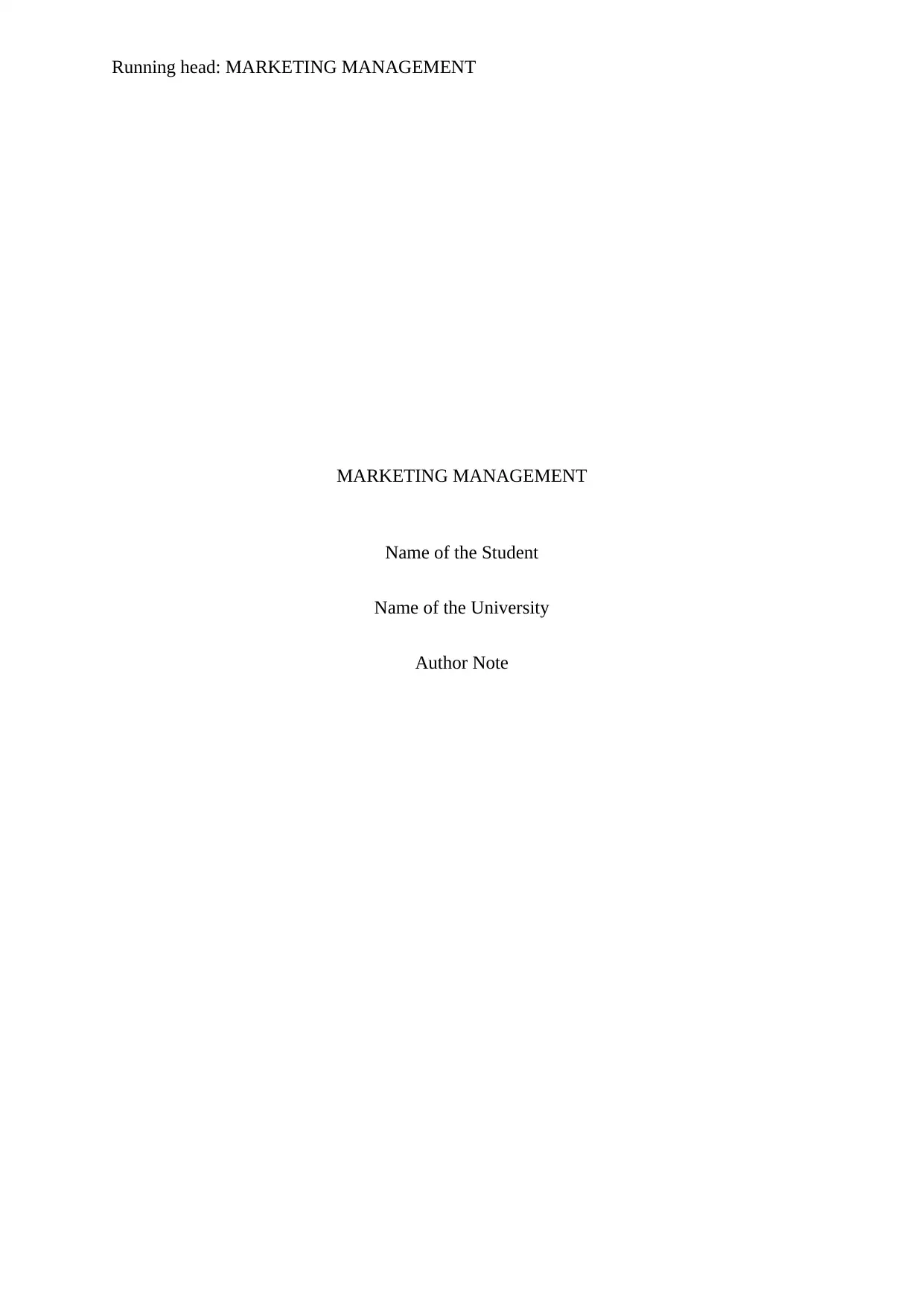
Running head: MARKETING MANAGEMENT
MARKETING MANAGEMENT
Name of the Student
Name of the University
Author Note
MARKETING MANAGEMENT
Name of the Student
Name of the University
Author Note
Paraphrase This Document
Need a fresh take? Get an instant paraphrase of this document with our AI Paraphraser
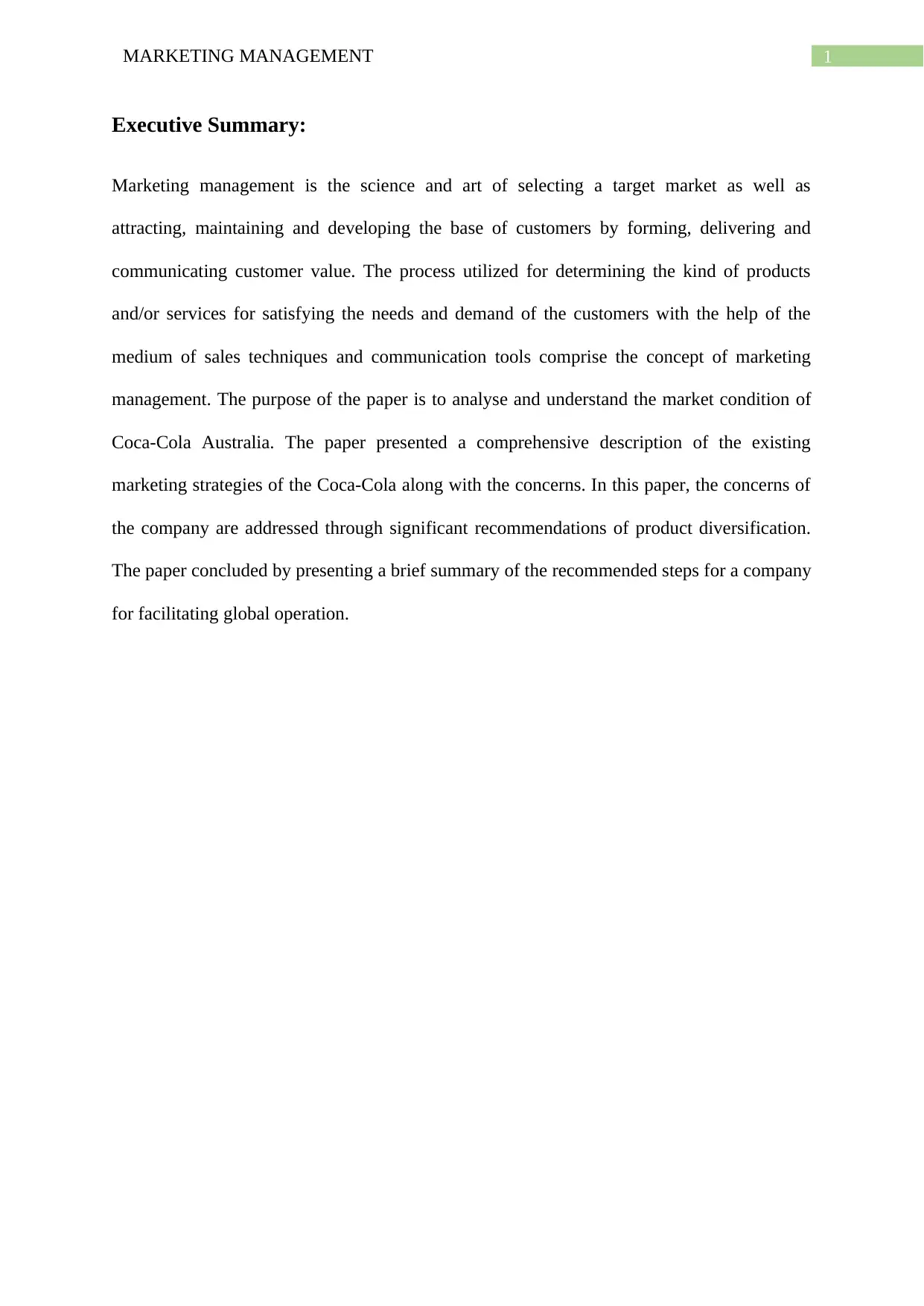
1MARKETING MANAGEMENT
Executive Summary:
Marketing management is the science and art of selecting a target market as well as
attracting, maintaining and developing the base of customers by forming, delivering and
communicating customer value. The process utilized for determining the kind of products
and/or services for satisfying the needs and demand of the customers with the help of the
medium of sales techniques and communication tools comprise the concept of marketing
management. The purpose of the paper is to analyse and understand the market condition of
Coca-Cola Australia. The paper presented a comprehensive description of the existing
marketing strategies of the Coca-Cola along with the concerns. In this paper, the concerns of
the company are addressed through significant recommendations of product diversification.
The paper concluded by presenting a brief summary of the recommended steps for a company
for facilitating global operation.
Executive Summary:
Marketing management is the science and art of selecting a target market as well as
attracting, maintaining and developing the base of customers by forming, delivering and
communicating customer value. The process utilized for determining the kind of products
and/or services for satisfying the needs and demand of the customers with the help of the
medium of sales techniques and communication tools comprise the concept of marketing
management. The purpose of the paper is to analyse and understand the market condition of
Coca-Cola Australia. The paper presented a comprehensive description of the existing
marketing strategies of the Coca-Cola along with the concerns. In this paper, the concerns of
the company are addressed through significant recommendations of product diversification.
The paper concluded by presenting a brief summary of the recommended steps for a company
for facilitating global operation.
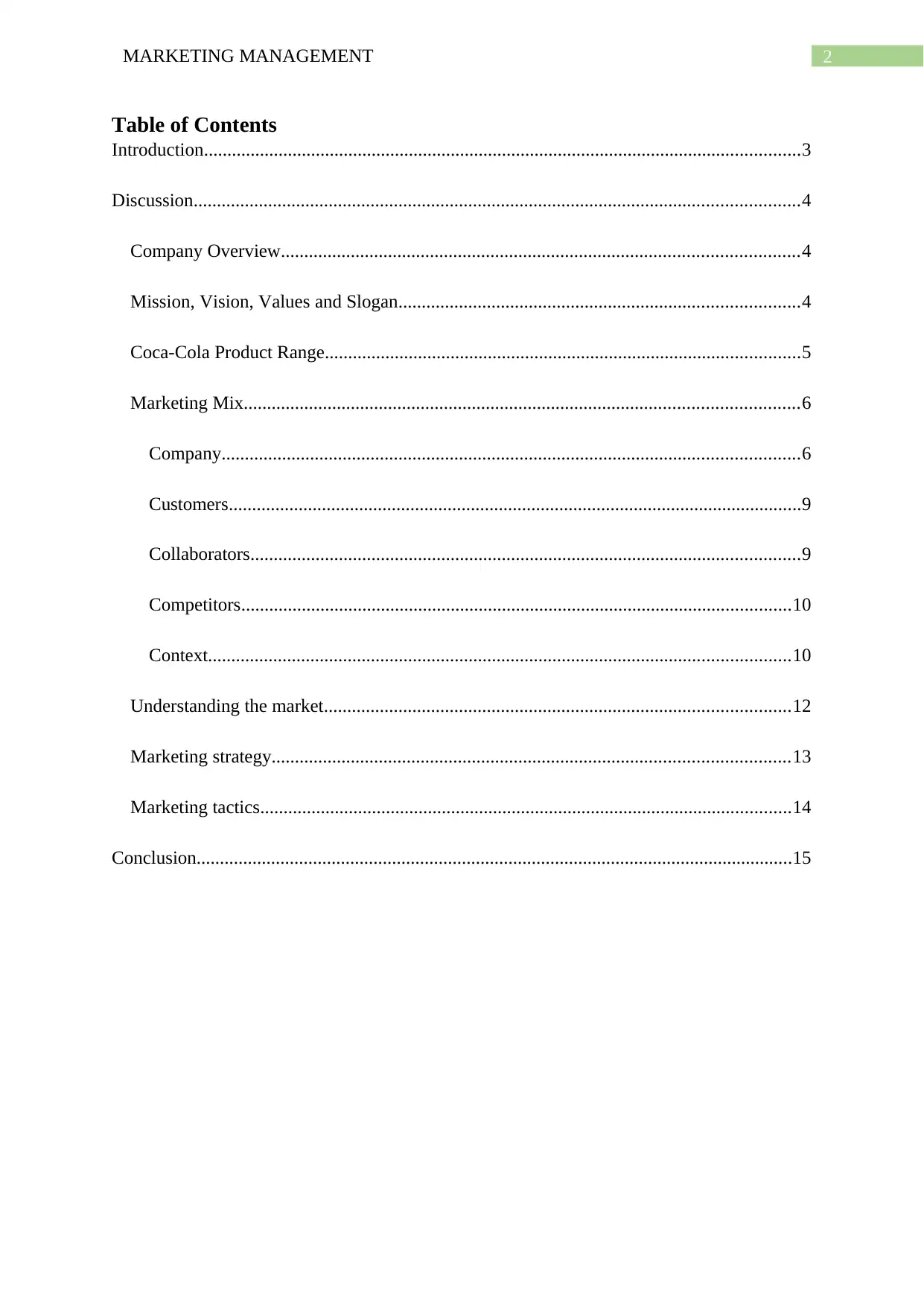
2MARKETING MANAGEMENT
Table of Contents
Introduction................................................................................................................................3
Discussion..................................................................................................................................4
Company Overview...............................................................................................................4
Mission, Vision, Values and Slogan......................................................................................4
Coca-Cola Product Range......................................................................................................5
Marketing Mix.......................................................................................................................6
Company............................................................................................................................6
Customers...........................................................................................................................9
Collaborators......................................................................................................................9
Competitors......................................................................................................................10
Context.............................................................................................................................10
Understanding the market....................................................................................................12
Marketing strategy...............................................................................................................13
Marketing tactics..................................................................................................................14
Conclusion................................................................................................................................15
Table of Contents
Introduction................................................................................................................................3
Discussion..................................................................................................................................4
Company Overview...............................................................................................................4
Mission, Vision, Values and Slogan......................................................................................4
Coca-Cola Product Range......................................................................................................5
Marketing Mix.......................................................................................................................6
Company............................................................................................................................6
Customers...........................................................................................................................9
Collaborators......................................................................................................................9
Competitors......................................................................................................................10
Context.............................................................................................................................10
Understanding the market....................................................................................................12
Marketing strategy...............................................................................................................13
Marketing tactics..................................................................................................................14
Conclusion................................................................................................................................15
⊘ This is a preview!⊘
Do you want full access?
Subscribe today to unlock all pages.

Trusted by 1+ million students worldwide
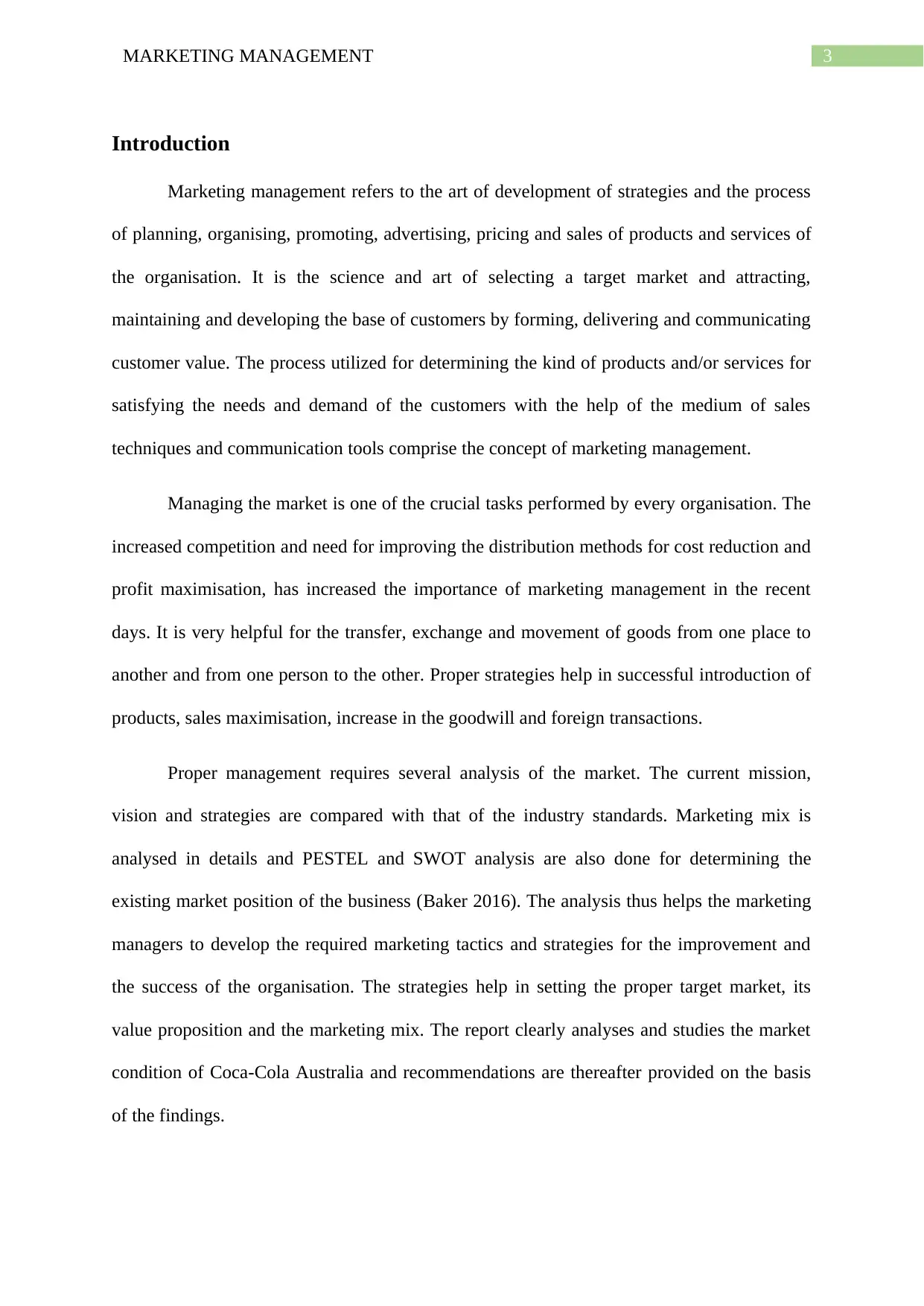
3MARKETING MANAGEMENT
Introduction
Marketing management refers to the art of development of strategies and the process
of planning, organising, promoting, advertising, pricing and sales of products and services of
the organisation. It is the science and art of selecting a target market and attracting,
maintaining and developing the base of customers by forming, delivering and communicating
customer value. The process utilized for determining the kind of products and/or services for
satisfying the needs and demand of the customers with the help of the medium of sales
techniques and communication tools comprise the concept of marketing management.
Managing the market is one of the crucial tasks performed by every organisation. The
increased competition and need for improving the distribution methods for cost reduction and
profit maximisation, has increased the importance of marketing management in the recent
days. It is very helpful for the transfer, exchange and movement of goods from one place to
another and from one person to the other. Proper strategies help in successful introduction of
products, sales maximisation, increase in the goodwill and foreign transactions.
Proper management requires several analysis of the market. The current mission,
vision and strategies are compared with that of the industry standards. Marketing mix is
analysed in details and PESTEL and SWOT analysis are also done for determining the
existing market position of the business (Baker 2016). The analysis thus helps the marketing
managers to develop the required marketing tactics and strategies for the improvement and
the success of the organisation. The strategies help in setting the proper target market, its
value proposition and the marketing mix. The report clearly analyses and studies the market
condition of Coca-Cola Australia and recommendations are thereafter provided on the basis
of the findings.
Introduction
Marketing management refers to the art of development of strategies and the process
of planning, organising, promoting, advertising, pricing and sales of products and services of
the organisation. It is the science and art of selecting a target market and attracting,
maintaining and developing the base of customers by forming, delivering and communicating
customer value. The process utilized for determining the kind of products and/or services for
satisfying the needs and demand of the customers with the help of the medium of sales
techniques and communication tools comprise the concept of marketing management.
Managing the market is one of the crucial tasks performed by every organisation. The
increased competition and need for improving the distribution methods for cost reduction and
profit maximisation, has increased the importance of marketing management in the recent
days. It is very helpful for the transfer, exchange and movement of goods from one place to
another and from one person to the other. Proper strategies help in successful introduction of
products, sales maximisation, increase in the goodwill and foreign transactions.
Proper management requires several analysis of the market. The current mission,
vision and strategies are compared with that of the industry standards. Marketing mix is
analysed in details and PESTEL and SWOT analysis are also done for determining the
existing market position of the business (Baker 2016). The analysis thus helps the marketing
managers to develop the required marketing tactics and strategies for the improvement and
the success of the organisation. The strategies help in setting the proper target market, its
value proposition and the marketing mix. The report clearly analyses and studies the market
condition of Coca-Cola Australia and recommendations are thereafter provided on the basis
of the findings.
Paraphrase This Document
Need a fresh take? Get an instant paraphrase of this document with our AI Paraphraser
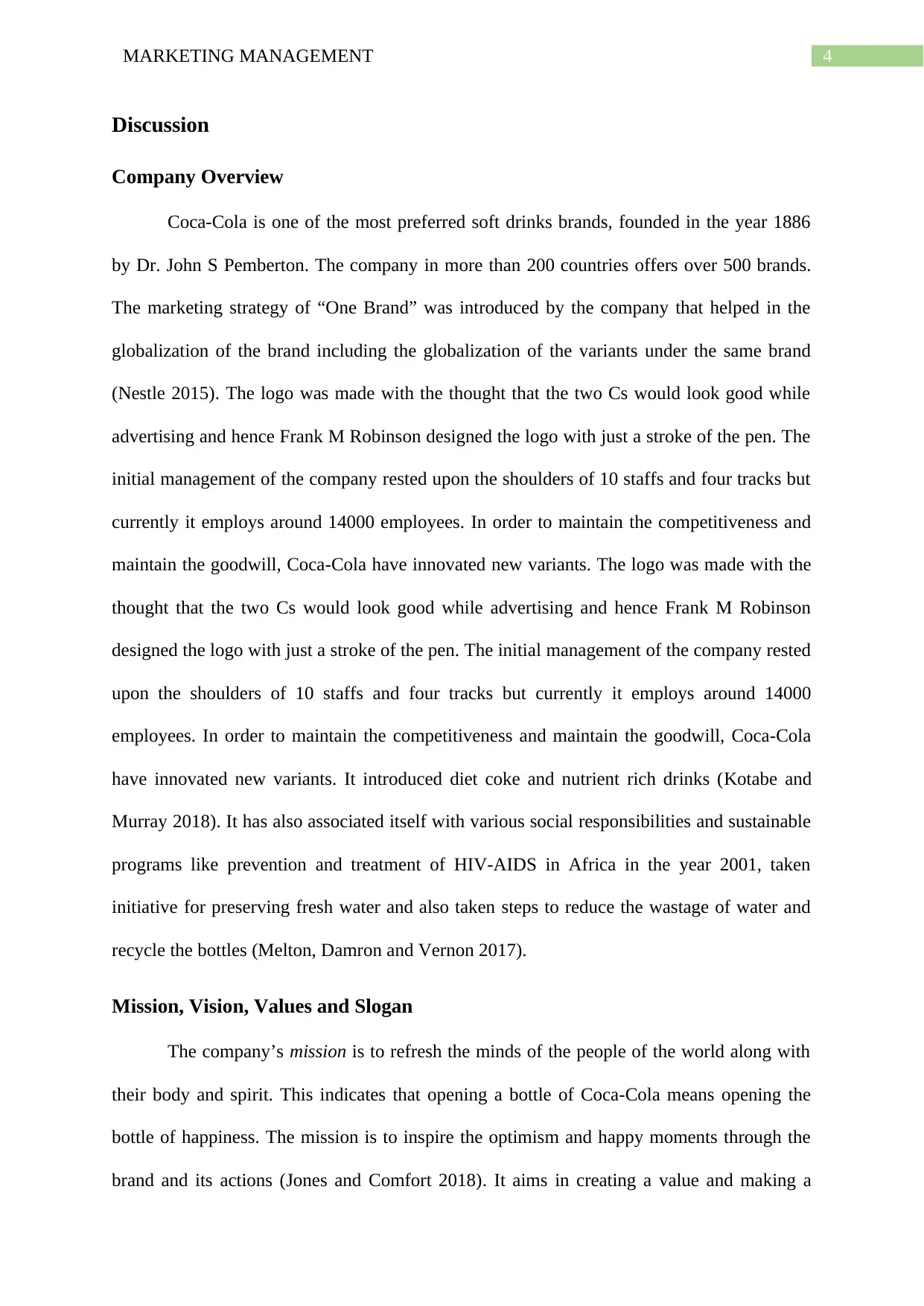
4MARKETING MANAGEMENT
Discussion
Company Overview
Coca-Cola is one of the most preferred soft drinks brands, founded in the year 1886
by Dr. John S Pemberton. The company in more than 200 countries offers over 500 brands.
The marketing strategy of “One Brand” was introduced by the company that helped in the
globalization of the brand including the globalization of the variants under the same brand
(Nestle 2015). The logo was made with the thought that the two Cs would look good while
advertising and hence Frank M Robinson designed the logo with just a stroke of the pen. The
initial management of the company rested upon the shoulders of 10 staffs and four tracks but
currently it employs around 14000 employees. In order to maintain the competitiveness and
maintain the goodwill, Coca-Cola have innovated new variants. The logo was made with the
thought that the two Cs would look good while advertising and hence Frank M Robinson
designed the logo with just a stroke of the pen. The initial management of the company rested
upon the shoulders of 10 staffs and four tracks but currently it employs around 14000
employees. In order to maintain the competitiveness and maintain the goodwill, Coca-Cola
have innovated new variants. It introduced diet coke and nutrient rich drinks (Kotabe and
Murray 2018). It has also associated itself with various social responsibilities and sustainable
programs like prevention and treatment of HIV-AIDS in Africa in the year 2001, taken
initiative for preserving fresh water and also taken steps to reduce the wastage of water and
recycle the bottles (Melton, Damron and Vernon 2017).
Mission, Vision, Values and Slogan
The company’s mission is to refresh the minds of the people of the world along with
their body and spirit. This indicates that opening a bottle of Coca-Cola means opening the
bottle of happiness. The mission is to inspire the optimism and happy moments through the
brand and its actions (Jones and Comfort 2018). It aims in creating a value and making a
Discussion
Company Overview
Coca-Cola is one of the most preferred soft drinks brands, founded in the year 1886
by Dr. John S Pemberton. The company in more than 200 countries offers over 500 brands.
The marketing strategy of “One Brand” was introduced by the company that helped in the
globalization of the brand including the globalization of the variants under the same brand
(Nestle 2015). The logo was made with the thought that the two Cs would look good while
advertising and hence Frank M Robinson designed the logo with just a stroke of the pen. The
initial management of the company rested upon the shoulders of 10 staffs and four tracks but
currently it employs around 14000 employees. In order to maintain the competitiveness and
maintain the goodwill, Coca-Cola have innovated new variants. The logo was made with the
thought that the two Cs would look good while advertising and hence Frank M Robinson
designed the logo with just a stroke of the pen. The initial management of the company rested
upon the shoulders of 10 staffs and four tracks but currently it employs around 14000
employees. In order to maintain the competitiveness and maintain the goodwill, Coca-Cola
have innovated new variants. It introduced diet coke and nutrient rich drinks (Kotabe and
Murray 2018). It has also associated itself with various social responsibilities and sustainable
programs like prevention and treatment of HIV-AIDS in Africa in the year 2001, taken
initiative for preserving fresh water and also taken steps to reduce the wastage of water and
recycle the bottles (Melton, Damron and Vernon 2017).
Mission, Vision, Values and Slogan
The company’s mission is to refresh the minds of the people of the world along with
their body and spirit. This indicates that opening a bottle of Coca-Cola means opening the
bottle of happiness. The mission is to inspire the optimism and happy moments through the
brand and its actions (Jones and Comfort 2018). It aims in creating a value and making a
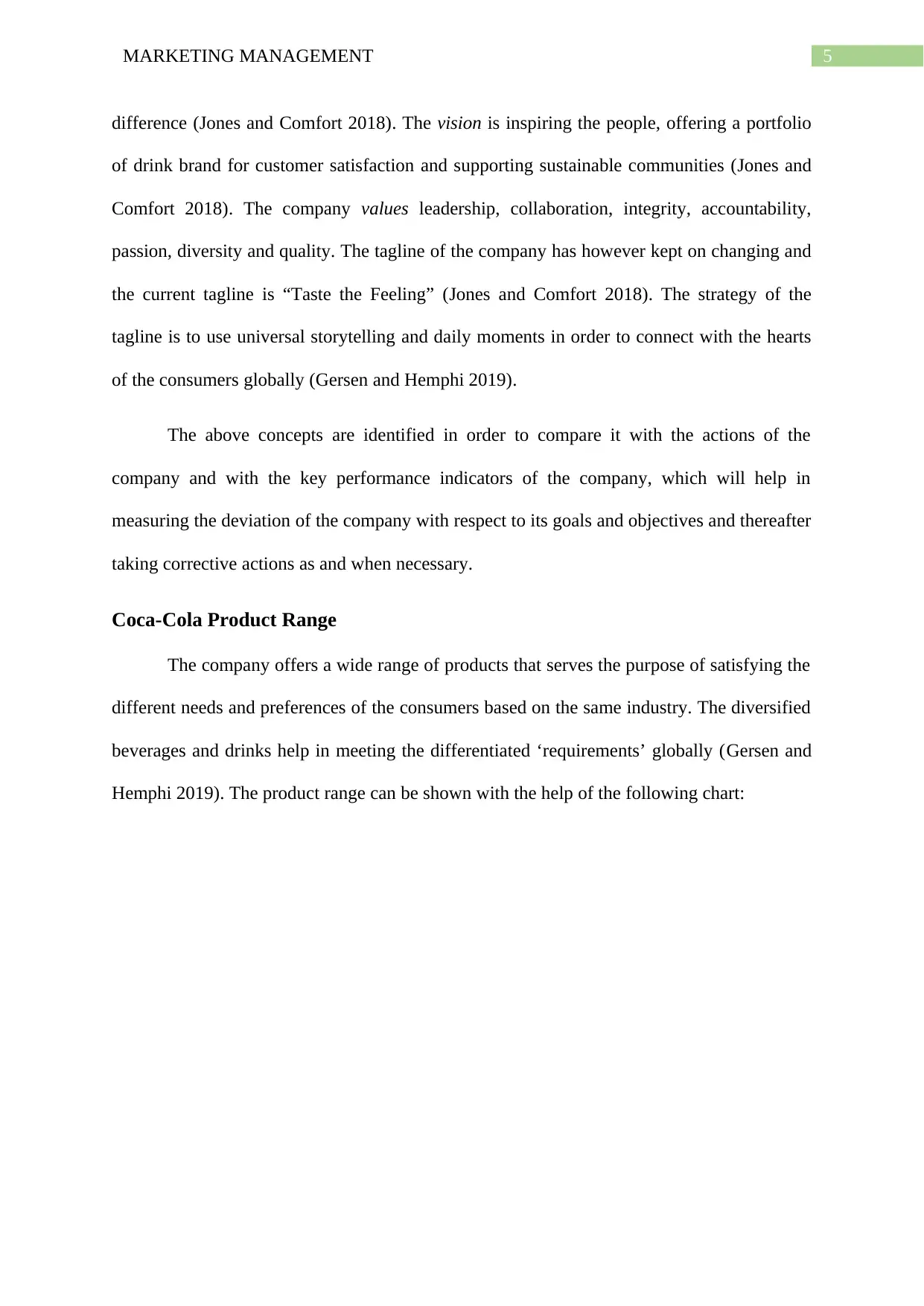
5MARKETING MANAGEMENT
difference (Jones and Comfort 2018). The vision is inspiring the people, offering a portfolio
of drink brand for customer satisfaction and supporting sustainable communities (Jones and
Comfort 2018). The company values leadership, collaboration, integrity, accountability,
passion, diversity and quality. The tagline of the company has however kept on changing and
the current tagline is “Taste the Feeling” (Jones and Comfort 2018). The strategy of the
tagline is to use universal storytelling and daily moments in order to connect with the hearts
of the consumers globally (Gersen and Hemphi 2019).
The above concepts are identified in order to compare it with the actions of the
company and with the key performance indicators of the company, which will help in
measuring the deviation of the company with respect to its goals and objectives and thereafter
taking corrective actions as and when necessary.
Coca-Cola Product Range
The company offers a wide range of products that serves the purpose of satisfying the
different needs and preferences of the consumers based on the same industry. The diversified
beverages and drinks help in meeting the differentiated ‘requirements’ globally (Gersen and
Hemphi 2019). The product range can be shown with the help of the following chart:
difference (Jones and Comfort 2018). The vision is inspiring the people, offering a portfolio
of drink brand for customer satisfaction and supporting sustainable communities (Jones and
Comfort 2018). The company values leadership, collaboration, integrity, accountability,
passion, diversity and quality. The tagline of the company has however kept on changing and
the current tagline is “Taste the Feeling” (Jones and Comfort 2018). The strategy of the
tagline is to use universal storytelling and daily moments in order to connect with the hearts
of the consumers globally (Gersen and Hemphi 2019).
The above concepts are identified in order to compare it with the actions of the
company and with the key performance indicators of the company, which will help in
measuring the deviation of the company with respect to its goals and objectives and thereafter
taking corrective actions as and when necessary.
Coca-Cola Product Range
The company offers a wide range of products that serves the purpose of satisfying the
different needs and preferences of the consumers based on the same industry. The diversified
beverages and drinks help in meeting the differentiated ‘requirements’ globally (Gersen and
Hemphi 2019). The product range can be shown with the help of the following chart:
⊘ This is a preview!⊘
Do you want full access?
Subscribe today to unlock all pages.

Trusted by 1+ million students worldwide
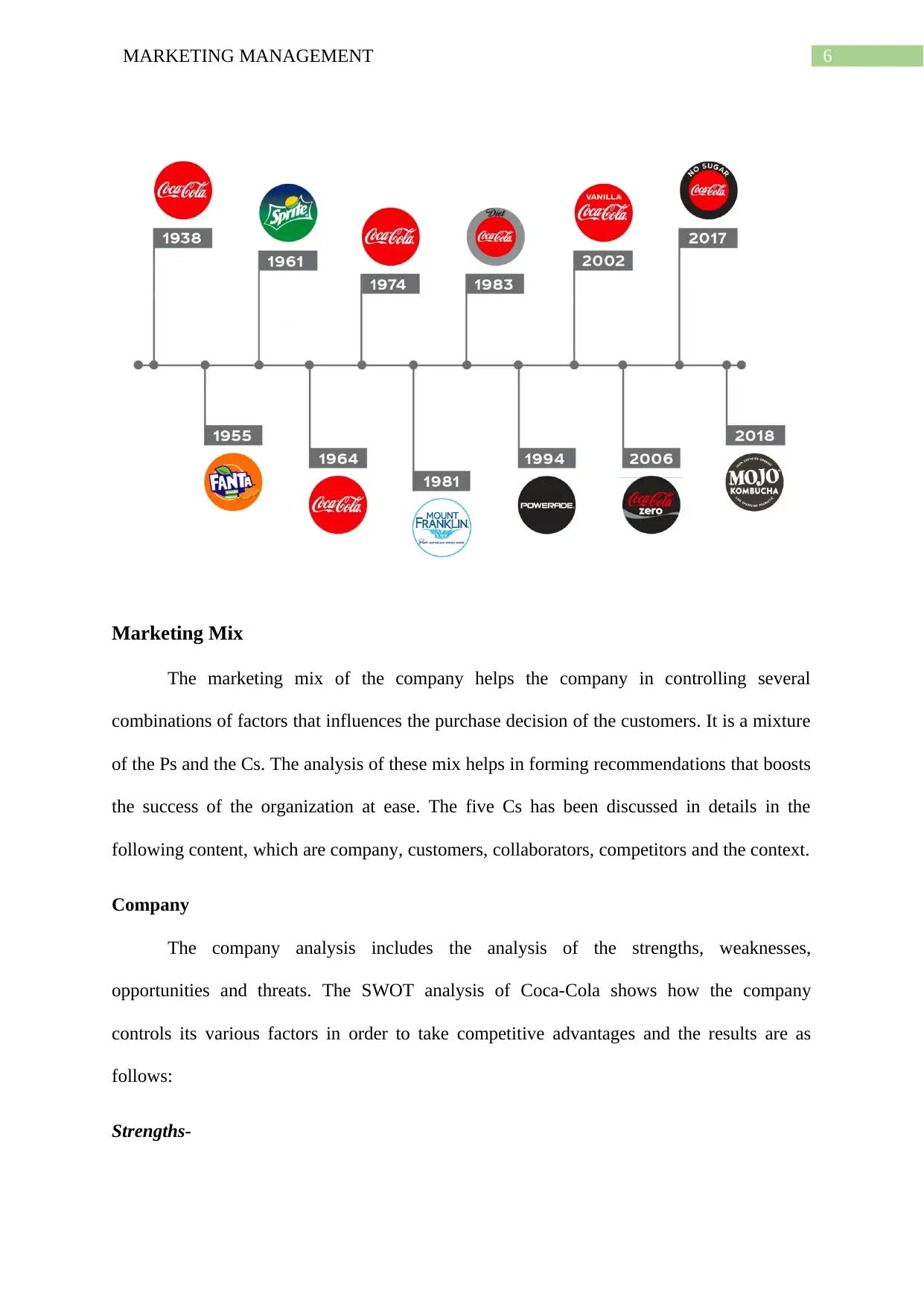
6MARKETING MANAGEMENT
Marketing Mix
The marketing mix of the company helps the company in controlling several
combinations of factors that influences the purchase decision of the customers. It is a mixture
of the Ps and the Cs. The analysis of these mix helps in forming recommendations that boosts
the success of the organization at ease. The five Cs has been discussed in details in the
following content, which are company, customers, collaborators, competitors and the context.
Company
The company analysis includes the analysis of the strengths, weaknesses,
opportunities and threats. The SWOT analysis of Coca-Cola shows how the company
controls its various factors in order to take competitive advantages and the results are as
follows:
Strengths-
Marketing Mix
The marketing mix of the company helps the company in controlling several
combinations of factors that influences the purchase decision of the customers. It is a mixture
of the Ps and the Cs. The analysis of these mix helps in forming recommendations that boosts
the success of the organization at ease. The five Cs has been discussed in details in the
following content, which are company, customers, collaborators, competitors and the context.
Company
The company analysis includes the analysis of the strengths, weaknesses,
opportunities and threats. The SWOT analysis of Coca-Cola shows how the company
controls its various factors in order to take competitive advantages and the results are as
follows:
Strengths-
Paraphrase This Document
Need a fresh take? Get an instant paraphrase of this document with our AI Paraphraser
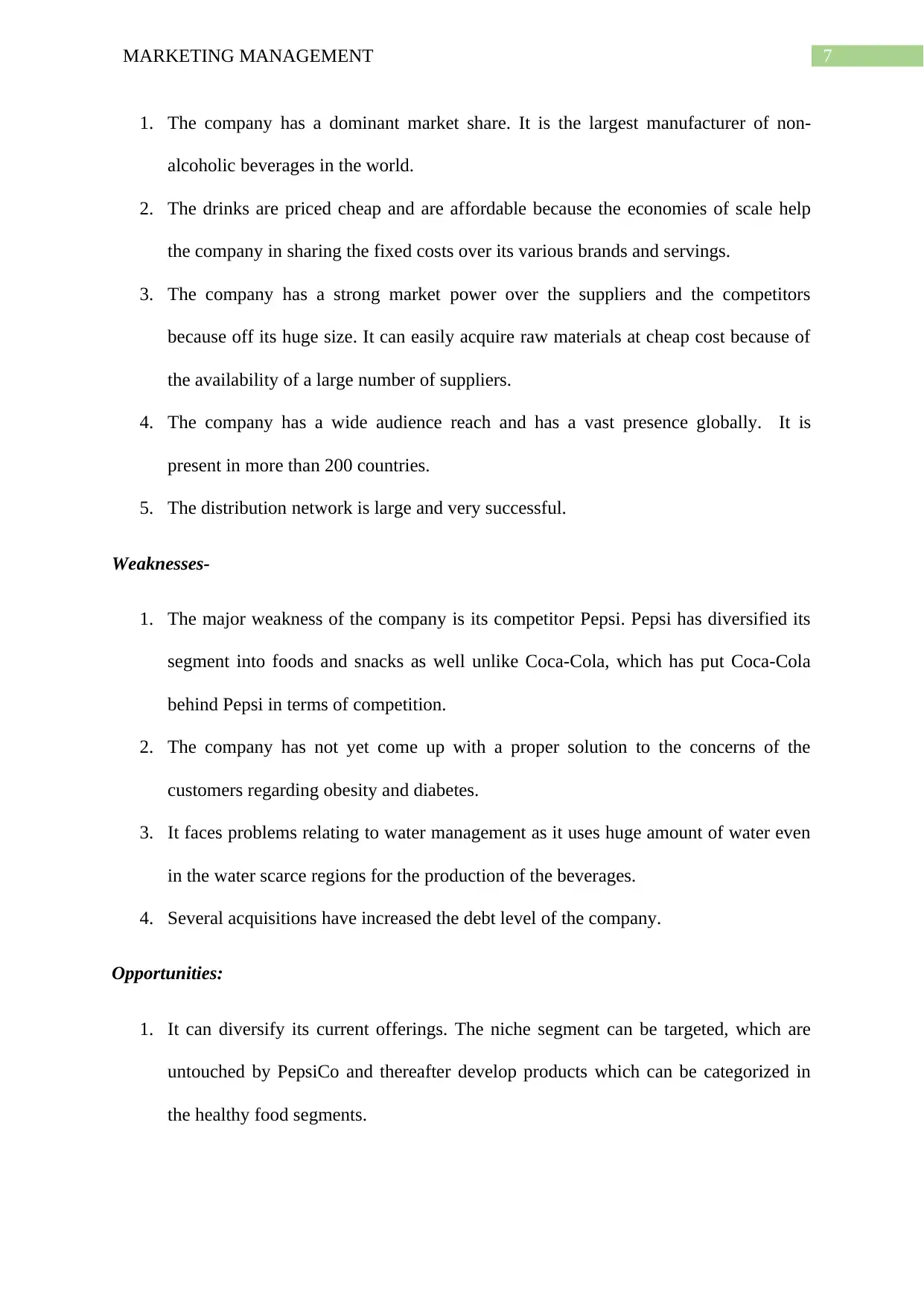
7MARKETING MANAGEMENT
1. The company has a dominant market share. It is the largest manufacturer of non-
alcoholic beverages in the world.
2. The drinks are priced cheap and are affordable because the economies of scale help
the company in sharing the fixed costs over its various brands and servings.
3. The company has a strong market power over the suppliers and the competitors
because off its huge size. It can easily acquire raw materials at cheap cost because of
the availability of a large number of suppliers.
4. The company has a wide audience reach and has a vast presence globally. It is
present in more than 200 countries.
5. The distribution network is large and very successful.
Weaknesses-
1. The major weakness of the company is its competitor Pepsi. Pepsi has diversified its
segment into foods and snacks as well unlike Coca-Cola, which has put Coca-Cola
behind Pepsi in terms of competition.
2. The company has not yet come up with a proper solution to the concerns of the
customers regarding obesity and diabetes.
3. It faces problems relating to water management as it uses huge amount of water even
in the water scarce regions for the production of the beverages.
4. Several acquisitions have increased the debt level of the company.
Opportunities:
1. It can diversify its current offerings. The niche segment can be targeted, which are
untouched by PepsiCo and thereafter develop products which can be categorized in
the healthy food segments.
1. The company has a dominant market share. It is the largest manufacturer of non-
alcoholic beverages in the world.
2. The drinks are priced cheap and are affordable because the economies of scale help
the company in sharing the fixed costs over its various brands and servings.
3. The company has a strong market power over the suppliers and the competitors
because off its huge size. It can easily acquire raw materials at cheap cost because of
the availability of a large number of suppliers.
4. The company has a wide audience reach and has a vast presence globally. It is
present in more than 200 countries.
5. The distribution network is large and very successful.
Weaknesses-
1. The major weakness of the company is its competitor Pepsi. Pepsi has diversified its
segment into foods and snacks as well unlike Coca-Cola, which has put Coca-Cola
behind Pepsi in terms of competition.
2. The company has not yet come up with a proper solution to the concerns of the
customers regarding obesity and diabetes.
3. It faces problems relating to water management as it uses huge amount of water even
in the water scarce regions for the production of the beverages.
4. Several acquisitions have increased the debt level of the company.
Opportunities:
1. It can diversify its current offerings. The niche segment can be targeted, which are
untouched by PepsiCo and thereafter develop products which can be categorized in
the healthy food segments.
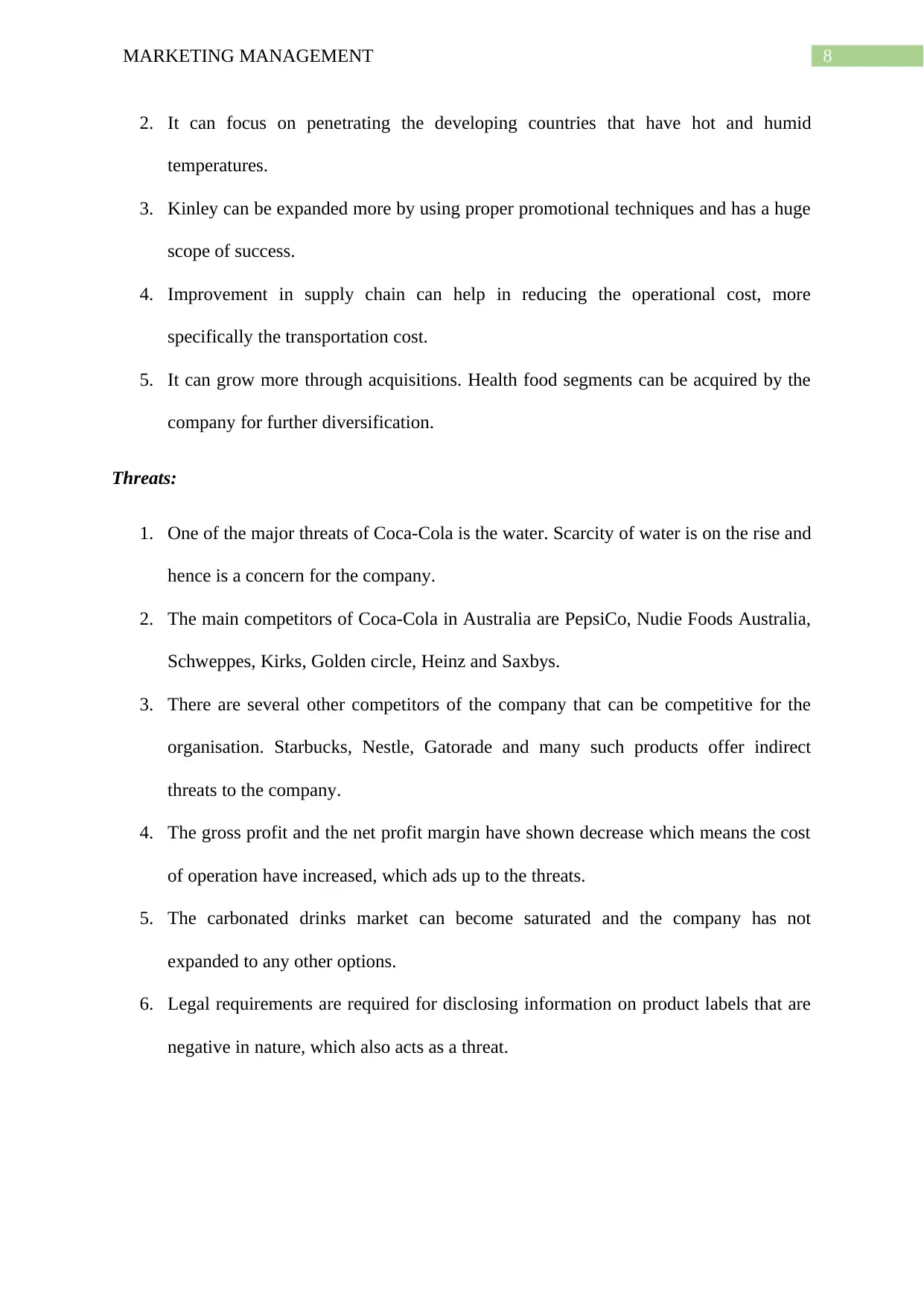
8MARKETING MANAGEMENT
2. It can focus on penetrating the developing countries that have hot and humid
temperatures.
3. Kinley can be expanded more by using proper promotional techniques and has a huge
scope of success.
4. Improvement in supply chain can help in reducing the operational cost, more
specifically the transportation cost.
5. It can grow more through acquisitions. Health food segments can be acquired by the
company for further diversification.
Threats:
1. One of the major threats of Coca-Cola is the water. Scarcity of water is on the rise and
hence is a concern for the company.
2. The main competitors of Coca-Cola in Australia are PepsiCo, Nudie Foods Australia,
Schweppes, Kirks, Golden circle, Heinz and Saxbys.
3. There are several other competitors of the company that can be competitive for the
organisation. Starbucks, Nestle, Gatorade and many such products offer indirect
threats to the company.
4. The gross profit and the net profit margin have shown decrease which means the cost
of operation have increased, which ads up to the threats.
5. The carbonated drinks market can become saturated and the company has not
expanded to any other options.
6. Legal requirements are required for disclosing information on product labels that are
negative in nature, which also acts as a threat.
2. It can focus on penetrating the developing countries that have hot and humid
temperatures.
3. Kinley can be expanded more by using proper promotional techniques and has a huge
scope of success.
4. Improvement in supply chain can help in reducing the operational cost, more
specifically the transportation cost.
5. It can grow more through acquisitions. Health food segments can be acquired by the
company for further diversification.
Threats:
1. One of the major threats of Coca-Cola is the water. Scarcity of water is on the rise and
hence is a concern for the company.
2. The main competitors of Coca-Cola in Australia are PepsiCo, Nudie Foods Australia,
Schweppes, Kirks, Golden circle, Heinz and Saxbys.
3. There are several other competitors of the company that can be competitive for the
organisation. Starbucks, Nestle, Gatorade and many such products offer indirect
threats to the company.
4. The gross profit and the net profit margin have shown decrease which means the cost
of operation have increased, which ads up to the threats.
5. The carbonated drinks market can become saturated and the company has not
expanded to any other options.
6. Legal requirements are required for disclosing information on product labels that are
negative in nature, which also acts as a threat.
⊘ This is a preview!⊘
Do you want full access?
Subscribe today to unlock all pages.

Trusted by 1+ million students worldwide
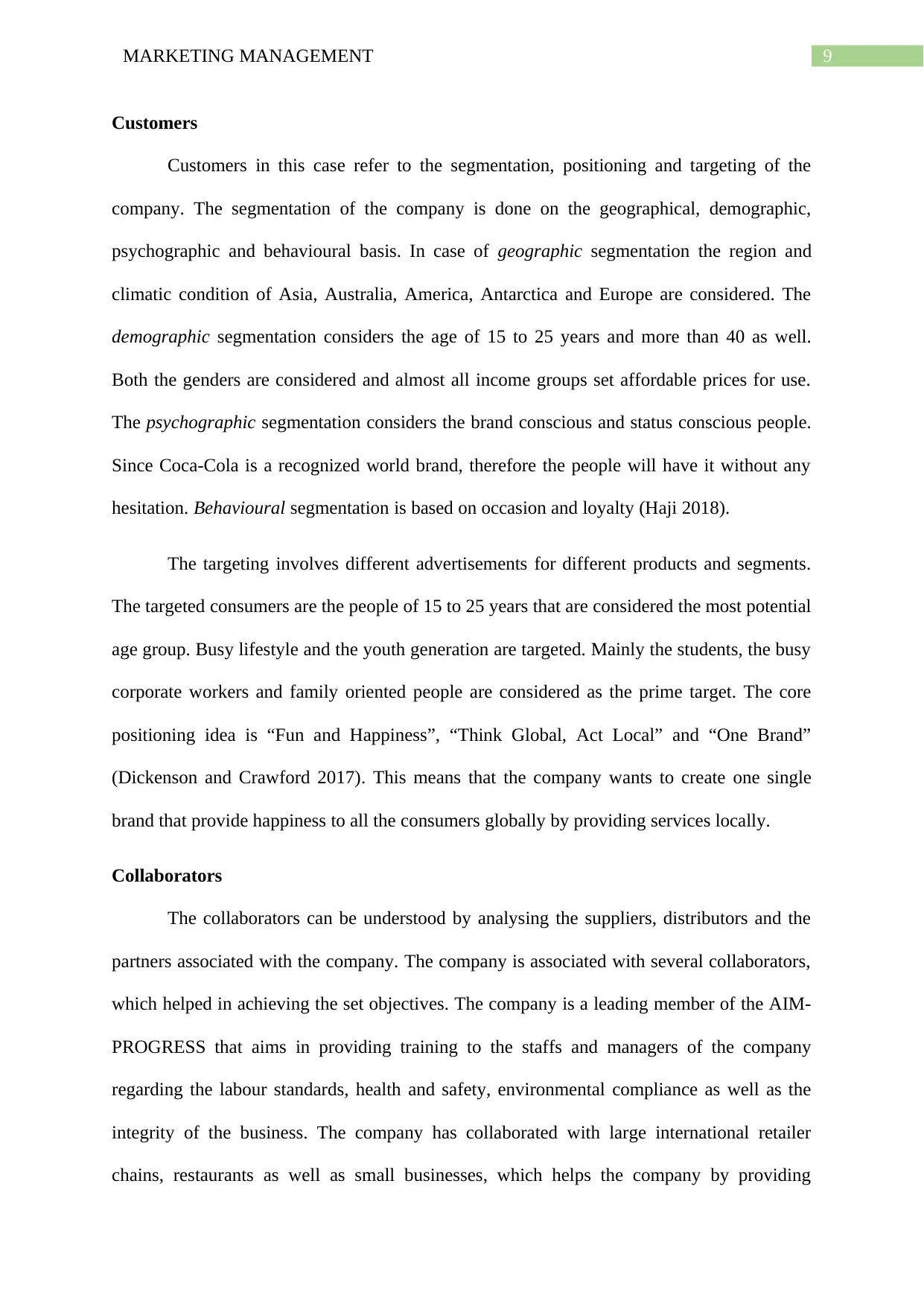
9MARKETING MANAGEMENT
Customers
Customers in this case refer to the segmentation, positioning and targeting of the
company. The segmentation of the company is done on the geographical, demographic,
psychographic and behavioural basis. In case of geographic segmentation the region and
climatic condition of Asia, Australia, America, Antarctica and Europe are considered. The
demographic segmentation considers the age of 15 to 25 years and more than 40 as well.
Both the genders are considered and almost all income groups set affordable prices for use.
The psychographic segmentation considers the brand conscious and status conscious people.
Since Coca-Cola is a recognized world brand, therefore the people will have it without any
hesitation. Behavioural segmentation is based on occasion and loyalty (Haji 2018).
The targeting involves different advertisements for different products and segments.
The targeted consumers are the people of 15 to 25 years that are considered the most potential
age group. Busy lifestyle and the youth generation are targeted. Mainly the students, the busy
corporate workers and family oriented people are considered as the prime target. The core
positioning idea is “Fun and Happiness”, “Think Global, Act Local” and “One Brand”
(Dickenson and Crawford 2017). This means that the company wants to create one single
brand that provide happiness to all the consumers globally by providing services locally.
Collaborators
The collaborators can be understood by analysing the suppliers, distributors and the
partners associated with the company. The company is associated with several collaborators,
which helped in achieving the set objectives. The company is a leading member of the AIM-
PROGRESS that aims in providing training to the staffs and managers of the company
regarding the labour standards, health and safety, environmental compliance as well as the
integrity of the business. The company has collaborated with large international retailer
chains, restaurants as well as small businesses, which helps the company by providing
Customers
Customers in this case refer to the segmentation, positioning and targeting of the
company. The segmentation of the company is done on the geographical, demographic,
psychographic and behavioural basis. In case of geographic segmentation the region and
climatic condition of Asia, Australia, America, Antarctica and Europe are considered. The
demographic segmentation considers the age of 15 to 25 years and more than 40 as well.
Both the genders are considered and almost all income groups set affordable prices for use.
The psychographic segmentation considers the brand conscious and status conscious people.
Since Coca-Cola is a recognized world brand, therefore the people will have it without any
hesitation. Behavioural segmentation is based on occasion and loyalty (Haji 2018).
The targeting involves different advertisements for different products and segments.
The targeted consumers are the people of 15 to 25 years that are considered the most potential
age group. Busy lifestyle and the youth generation are targeted. Mainly the students, the busy
corporate workers and family oriented people are considered as the prime target. The core
positioning idea is “Fun and Happiness”, “Think Global, Act Local” and “One Brand”
(Dickenson and Crawford 2017). This means that the company wants to create one single
brand that provide happiness to all the consumers globally by providing services locally.
Collaborators
The collaborators can be understood by analysing the suppliers, distributors and the
partners associated with the company. The company is associated with several collaborators,
which helped in achieving the set objectives. The company is a leading member of the AIM-
PROGRESS that aims in providing training to the staffs and managers of the company
regarding the labour standards, health and safety, environmental compliance as well as the
integrity of the business. The company has collaborated with large international retailer
chains, restaurants as well as small businesses, which helps the company by providing
Paraphrase This Document
Need a fresh take? Get an instant paraphrase of this document with our AI Paraphraser
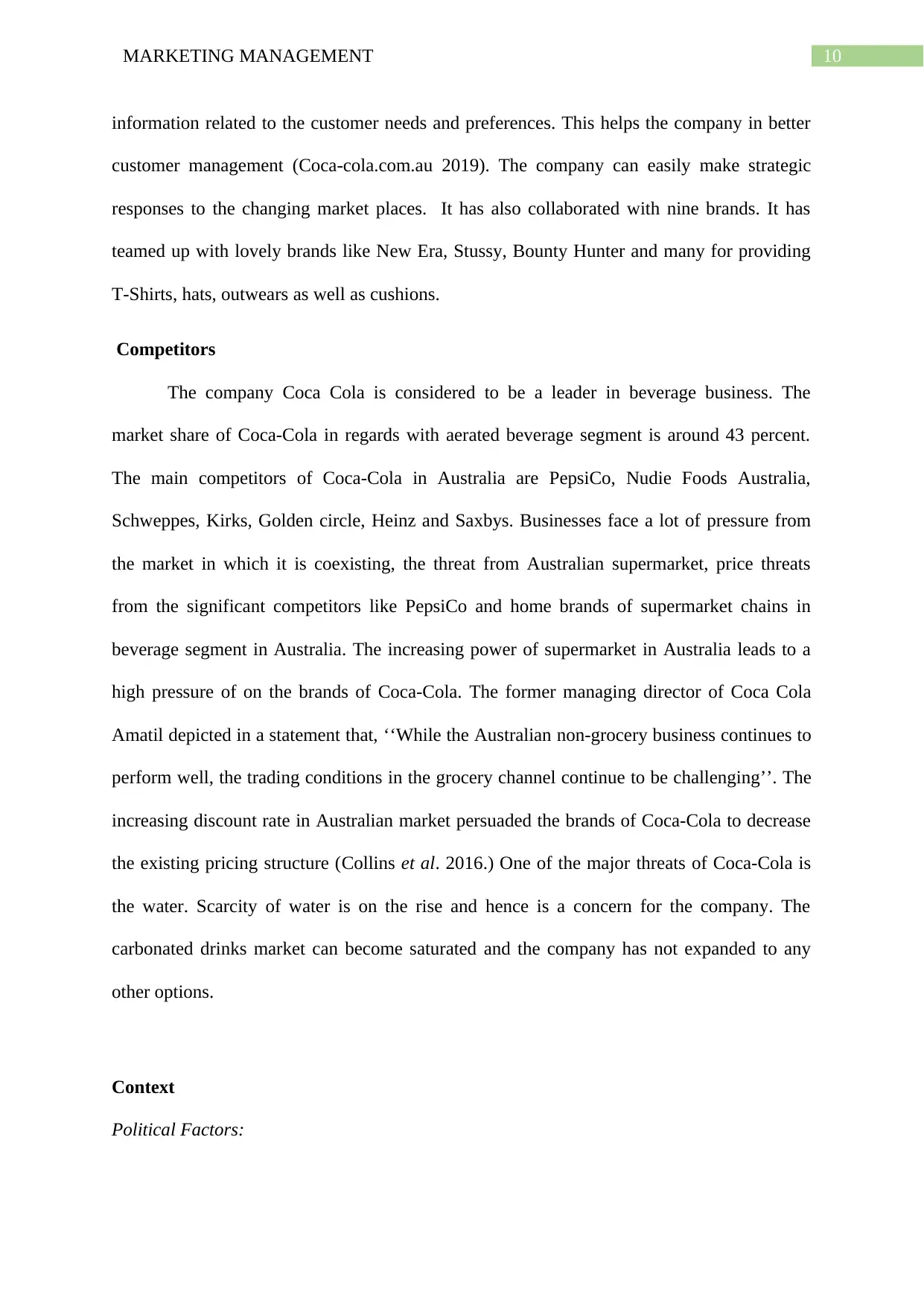
10MARKETING MANAGEMENT
information related to the customer needs and preferences. This helps the company in better
customer management (Coca-cola.com.au 2019). The company can easily make strategic
responses to the changing market places. It has also collaborated with nine brands. It has
teamed up with lovely brands like New Era, Stussy, Bounty Hunter and many for providing
T-Shirts, hats, outwears as well as cushions.
Competitors
The company Coca Cola is considered to be a leader in beverage business. The
market share of Coca-Cola in regards with aerated beverage segment is around 43 percent.
The main competitors of Coca-Cola in Australia are PepsiCo, Nudie Foods Australia,
Schweppes, Kirks, Golden circle, Heinz and Saxbys. Businesses face a lot of pressure from
the market in which it is coexisting, the threat from Australian supermarket, price threats
from the significant competitors like PepsiCo and home brands of supermarket chains in
beverage segment in Australia. The increasing power of supermarket in Australia leads to a
high pressure of on the brands of Coca-Cola. The former managing director of Coca Cola
Amatil depicted in a statement that, ‘‘While the Australian non-grocery business continues to
perform well, the trading conditions in the grocery channel continue to be challenging’’. The
increasing discount rate in Australian market persuaded the brands of Coca-Cola to decrease
the existing pricing structure (Collins et al. 2016.) One of the major threats of Coca-Cola is
the water. Scarcity of water is on the rise and hence is a concern for the company. The
carbonated drinks market can become saturated and the company has not expanded to any
other options.
Context
Political Factors:
information related to the customer needs and preferences. This helps the company in better
customer management (Coca-cola.com.au 2019). The company can easily make strategic
responses to the changing market places. It has also collaborated with nine brands. It has
teamed up with lovely brands like New Era, Stussy, Bounty Hunter and many for providing
T-Shirts, hats, outwears as well as cushions.
Competitors
The company Coca Cola is considered to be a leader in beverage business. The
market share of Coca-Cola in regards with aerated beverage segment is around 43 percent.
The main competitors of Coca-Cola in Australia are PepsiCo, Nudie Foods Australia,
Schweppes, Kirks, Golden circle, Heinz and Saxbys. Businesses face a lot of pressure from
the market in which it is coexisting, the threat from Australian supermarket, price threats
from the significant competitors like PepsiCo and home brands of supermarket chains in
beverage segment in Australia. The increasing power of supermarket in Australia leads to a
high pressure of on the brands of Coca-Cola. The former managing director of Coca Cola
Amatil depicted in a statement that, ‘‘While the Australian non-grocery business continues to
perform well, the trading conditions in the grocery channel continue to be challenging’’. The
increasing discount rate in Australian market persuaded the brands of Coca-Cola to decrease
the existing pricing structure (Collins et al. 2016.) One of the major threats of Coca-Cola is
the water. Scarcity of water is on the rise and hence is a concern for the company. The
carbonated drinks market can become saturated and the company has not expanded to any
other options.
Context
Political Factors:
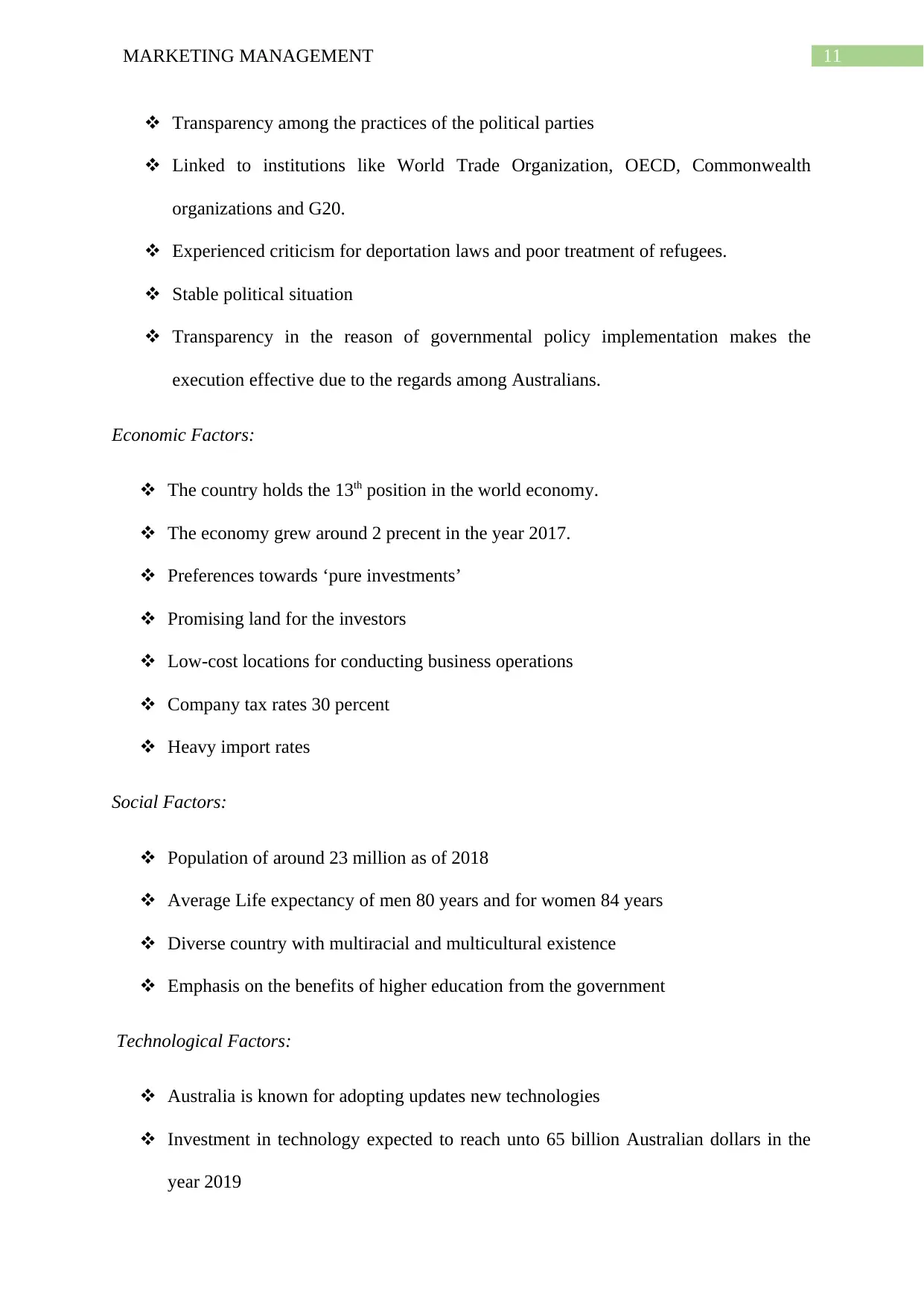
11MARKETING MANAGEMENT
Transparency among the practices of the political parties
Linked to institutions like World Trade Organization, OECD, Commonwealth
organizations and G20.
Experienced criticism for deportation laws and poor treatment of refugees.
Stable political situation
Transparency in the reason of governmental policy implementation makes the
execution effective due to the regards among Australians.
Economic Factors:
The country holds the 13th position in the world economy.
The economy grew around 2 precent in the year 2017.
Preferences towards ‘pure investments’
Promising land for the investors
Low-cost locations for conducting business operations
Company tax rates 30 percent
Heavy import rates
Social Factors:
Population of around 23 million as of 2018
Average Life expectancy of men 80 years and for women 84 years
Diverse country with multiracial and multicultural existence
Emphasis on the benefits of higher education from the government
Technological Factors:
Australia is known for adopting updates new technologies
Investment in technology expected to reach unto 65 billion Australian dollars in the
year 2019
Transparency among the practices of the political parties
Linked to institutions like World Trade Organization, OECD, Commonwealth
organizations and G20.
Experienced criticism for deportation laws and poor treatment of refugees.
Stable political situation
Transparency in the reason of governmental policy implementation makes the
execution effective due to the regards among Australians.
Economic Factors:
The country holds the 13th position in the world economy.
The economy grew around 2 precent in the year 2017.
Preferences towards ‘pure investments’
Promising land for the investors
Low-cost locations for conducting business operations
Company tax rates 30 percent
Heavy import rates
Social Factors:
Population of around 23 million as of 2018
Average Life expectancy of men 80 years and for women 84 years
Diverse country with multiracial and multicultural existence
Emphasis on the benefits of higher education from the government
Technological Factors:
Australia is known for adopting updates new technologies
Investment in technology expected to reach unto 65 billion Australian dollars in the
year 2019
⊘ This is a preview!⊘
Do you want full access?
Subscribe today to unlock all pages.

Trusted by 1+ million students worldwide
1 out of 18
Related Documents
Your All-in-One AI-Powered Toolkit for Academic Success.
+13062052269
info@desklib.com
Available 24*7 on WhatsApp / Email
![[object Object]](/_next/static/media/star-bottom.7253800d.svg)
Unlock your academic potential
Copyright © 2020–2025 A2Z Services. All Rights Reserved. Developed and managed by ZUCOL.




